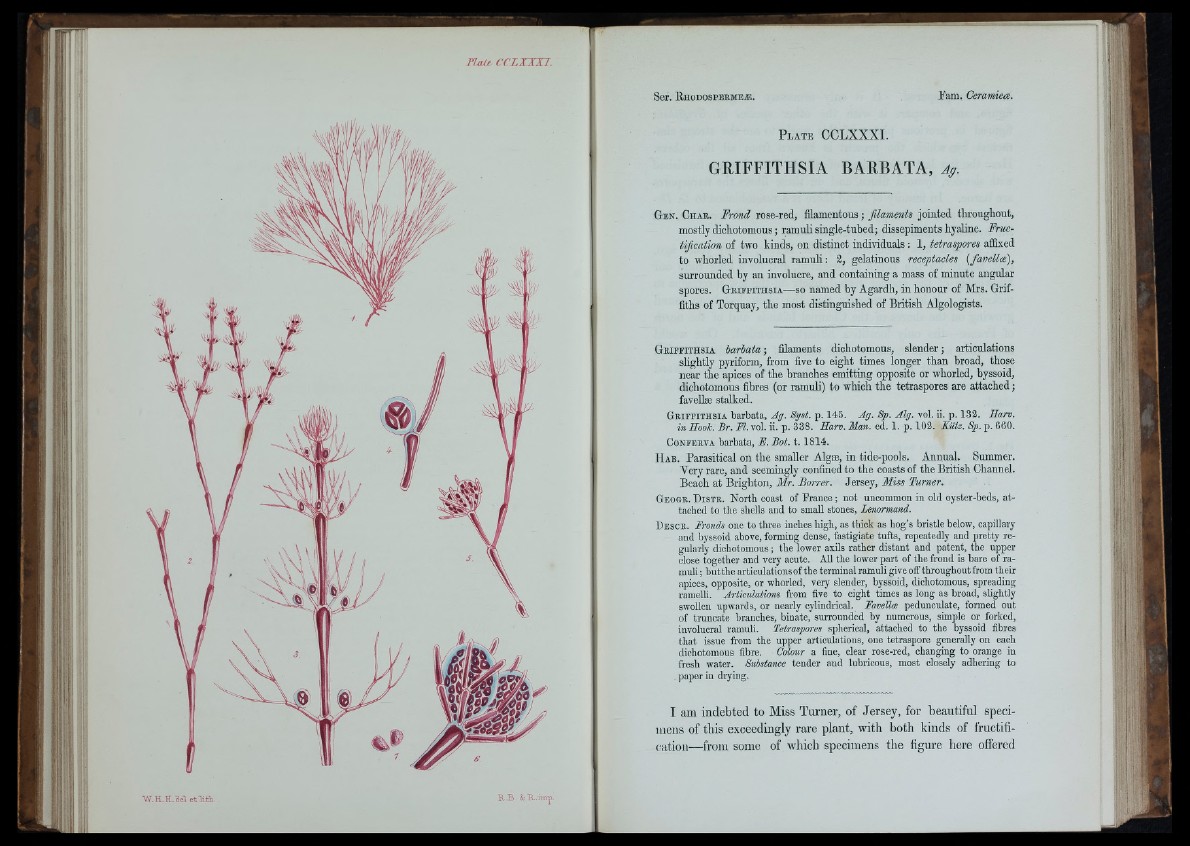
W .H .H . J a e t l i S i . R .B . f c R . im j .
P l a t e CCLXXXI.
GRIFFITHSIA BARBATA, Ag.
G e n . Ch a r . Frond rose-red, filamentous; filaments jointed tliroughout,
mostly dichotomous; ramuh single-tubed; dissepiments hyaline. Fructification
of two kinds, on distinct individuals : 1, tetraspores affixed
to whorled involucral ramuli: 3, gelatinous receptacles [fa v e lla ],
surrounded by an involucre, and containing a mass of minute angular
spores. G e if f it h s ia—so named by Agardh, in honour of Mrs. Griffiths
of Torquay, the most distinguished of British Algologists.
G e if f it h s ia barbata ; filaments dichotomous, slender ; articulations
slightly pyriform, from five to eight times longer than broad, those
near the apices of the branches emitting opposite or whorled, byssoid,
dichotomous fibres (or ramuh) to which the tetraspores are attached ;
favellæ stalked.
Ge if f it h s ia barbata, Ag. Syst. p. 145. Ag. Sp. Alg. vol. ii. p. 132. E a n .
in Eook. Br. M. vol. ii. p. 338. Harv. Man. ed. 1. p. 102. Kiitz. Sp. p. 660.
Conferva barbata, E. Bot. 1 .1814.
H ab. Parasitical on the smaller Algæ, in tide-pools. Annual. Summer.
Very rare, and seemingly confined to the coasts of the British Channel.
Beach at Brighton, M r. Borrer. Jersey, Miss Turner.
G e o g r . D i s t r . N orth coast of F ran c e ; not uncommon in old oyster-beds, a ttached
to the shells and to small stones, Lenormand.
D e sc r . Fronds one to three inches high, as thick as hog’s bristle below, capillary
and byssoid above, forming dense, fastigiate tufts, repeatedly and pretty regularly
dichotomous ; the lower axils rather distant and patent, the upper
close together and very acute. All the lower part of the frond is bare of ramuli;
butthe articulationsof the terminal ramuli give off throughout from their
apices, opposite, or whorled, very slender, byssoid, dichotomous, spreading
rameUi. Articulations from five to eight times as long as broad, slightly
swollen upwards, or nearly cylindrical. Favella pedunculate, formed out
of truncate branches, binate, surrounded by numerous, simple or forked,
involucral ramuli. Tetraspores spherical, attached to the byssoid fibres
that issue from the upper articulations, one tetraspore generally on each
dichotomous fibre. Colour a fine, clear rose-red, changing to orange in
fresh water. Substance tender and lubricous, most closely adhering to
paper in drying.
I am indebted to Miss Turner, of Jersey, for beautiful specimens
of this exceedingly rare plant, with both kinds of fructification—
from some of which specimens the figure here offered
I
I I'l